Garden Hand Tools, Rakes
The Best types of Rakes that will benefit your garden and lawn
Last Updated on March 25, 2024 by Editors
Possibly the rake is the most versatile garden hand tool and one of the gardener’s best friends. In this useful guide we take a deep dive into the different types of rakes and their uses. In addition, we included a useful buying guide to help you choose the right rake type.
Table of Contents
What is a rake
Rake is a tool that usually consists of a head, tines (teeth) and a handle. As a garden tool it’s widely used to level and smooth soil, rake small stones/gravel/twigs, remove thatch and leaves in garden, lawn and patio areas.
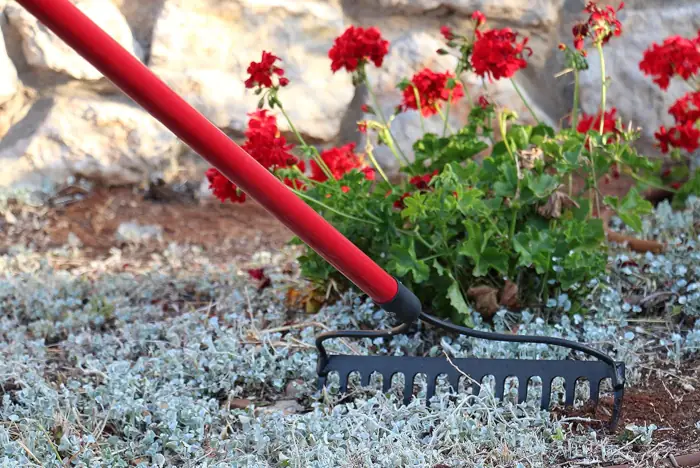
Many different types of rakes can be beneficial for your garden and lawn. Leaf rakes are great for gathering leaves and debris, while garden rakes can help to loosen up the soil and remove weeds. Lawn rakes can also be used to level out your lawn and remove any dead grass or moss. Choosing the right rake for the job will make it much easier to keep your garden and lawn looking neat and tidy.
What is a rake used for?
Different types of rakes can complete many gardening tasks. Typically, you can use rakes to:
- spread soil
- level soil
- remove debris
- rake gravel and small rocks
- sweep leaves in garden, lawn and patio areas.
Types of rakes
For every kind of soil that needs leveling there’s a specific rake type for it. In this guide we’ll focus on the types of rakes used in outdoor living areas. There are dozens of different types of rakes. Gravel rakes, olive rakes (not too sturdy by the way), rakes to collect berries or hazelnuts, screening rakes, lawn rakes, zen garden rakes, pond rakes, ash rakes, roof rakes. Usually the rake types differ on the head height and width, tines’ length, width and number, handle, head and tines material, overall rake length and, of course, functionality.
There are two and a half basic types of rakes: The garden rake, the leaf rake and the hand rake (that’s the half).
1. The Classic Rake
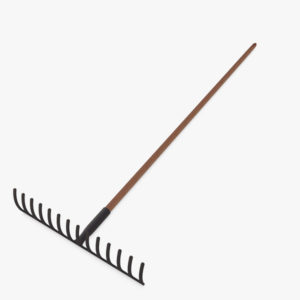
Also known as garden rake, it is the most common rake type. It has a T-shaped metal head and straight or curved tines. You will see it in the garden shed of every house and in the tool rack of every gardening or tool store. The reasons for this are many. It has the most strong and durable rake design, it’s not too expensive and it can be used for almost every raking task including:
- breaking up hard compacted soil
- spreading compost or gravel
- leveling topsoil and sand
Additionally, it’s strong enough to weed, remove debris and move small rocks.
So, why are there more rake types, what’s the catch?
Most of the time this great all-around rake comes in one size and weight. However, its head is HEAVY, its handle is long enough to annoy some people and can’t be used to remove big amounts of dead leaves. The garden rake has short pointy tines. The leaves can get stuck in and between the tines and you have to bend over to remove them. Nevertheless, it’s a must-have multi-purpose garden tool.
2. Landscaping Rake
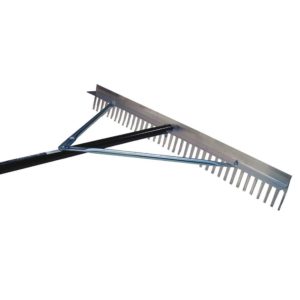
The landscaping rake is almost the same as the classic garden rake, but with a much wider head and more tines. Can be used to spread material, level and smooth out large areas better and faster than the garden rake. The downside is that landscaping rakes can’t be used for raking in closely spaced areas.
3. Bow Rake

The bow rake is just a garden rake with a metal bow shape that connects the handle with the rake’s head. Usually the bow rake’s tines are curved. Its head is not as sturdy as the garden rake’s head but offers a little bit better stability.
4. Leaf Rakes

This type of rake can be used for the one task that the classic garden rake is unable to accomplish. About half of the leaf rake models on the market come with a simple mechanism that adjusts and locks the width of their head’s flexible tines. The leaf rake has longer tines than the classic garden rake and can remove and move dead leaves easily and without many annoyances. And that’s it, it must be used gently and only for cleaning leaves or other lightweight small debris off your patio, garden or lawn.
There is a specialized leaf rake offspring called lawn rake. Be careful when raking with leaf rakes. Most of them have delicate heads made of poor or thin material, whether it’s metal, plastic or bamboo, that break easily and very thin tines that bend permanently! If you are planning to buy a leaf rake then choose one with sturdy, thick and long metal tines. It’s heavier, its head doesn’t spread the tines as much as the other leaf rake heads but it will last a lot longer.
5. Thatching Rake

Also known as thatch or dethatching rake, its purpose is to dethatch the lawn (remove thatch) as its name suggests. The thatching rake features a head with tines on both ends.
6. Lawn Leveling Rake
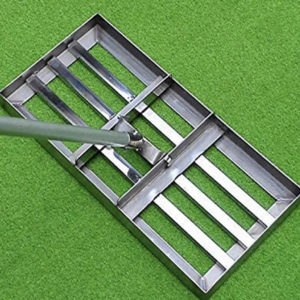
The lawn leveling rake’s head is a large flat ground plate instead of a head with tines. This lawn leveling tool is specialized to work on any type of grass. Also, the lawn leveling rake can be used to flatten soil, compost, sand and other ground surfaces in garden and lawn.
7. Shrub Rake
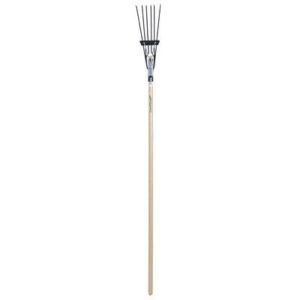
A lightweight rake with flexible tines and, unlike leaf rakes, with a not too big of a head. It will let you work in narrow spaces with more control and greater precision.
8. Hand Rakes
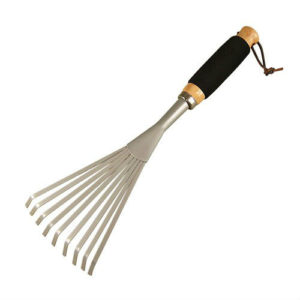
A garden rake, small enough to get between shrubs and flower beds which is very handy for raking up dead leaves around bushes and plants. It’s a rake tool that must be included in every garden tool arsenal.
Rake Buying Guide – How to decide which one to buy
With so many rake types, sometimes it is hard to know which one to choose. It all comes down to your garden’s and outdoor living areas’ needs. There are some important things to consider before buying a rake. Choosing the right type of rake will help you finish your gardening tasks faster, keep your garden healthy and your patio areas leaf-free. We prepared a guide for you, which includes some tips that will help you buy the right rake tool type. For further guidance, please read our rake buying guide below.
How to choose the right rake
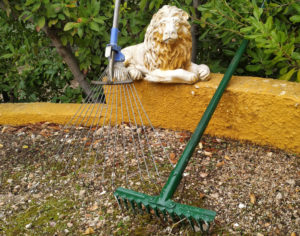
If there are any deciduous (shedding its leaves annually) trees or plants near your patio or in your garden areas then you ‘ll have to buy, at least, a leaf rake to clean the fallen leaves and twigs.
In addition, you can use the leaf rake to remove leaves from your lawn. There is a special rake type for this task called lawn rake. A classic garden or a bow rake can do the trick too but you should avoid using them for this task. These multipurpose rake tools are good enough for all other tasks like light weeding, moving gravel, smoothing and leveling soil.
Prefer a hand rake for raking in small and tight spaces that require delicate touches.
You should choose a thatch rake to aerate and remove thatch from lawns.
For heavy-duty landscaping tasks you have to choose other gardening hand tools like a garden hoe tool or a garden shovel.
For all these reasons, we gathered information about the most useful rake types you need to know before buying one.
Which is the best place to buy rakes?
High-quality rakes are must-haves for your gardening tool shed or garden tool rack. Generally, a garden rake or bow rake, a leaf rake and a hand rake are enough for most houses with garden, lawn or patio areas. The cost is about 50 bucks (or more – if you so wish) for a simple garden rake or bow rake, a random hand rake and a durable leaf rake.
The best place to find and buy rakes is your local store. Visit a hardware store, pick one, hold it in your hand, make sure it has a comfortable grip, ergonomic handle, feel its weight and center of gravity and imagine yourself using it (raking). If you don’t have any in your neighborhood and plan to buy from online stores then you can look at Amazon’s big collection of rakes. There are rakes for every budget and every need.
6 things to consider when planning to buy a rake online
 We emphasized a small collection of advices gathered from our experience to help you avoid unpleasant surprises when raking and stop from purchasing rakes again and again:
We emphasized a small collection of advices gathered from our experience to help you avoid unpleasant surprises when raking and stop from purchasing rakes again and again:
- Check the rake’s listed weight. If the rake’s material is lightweight and not flexible it may be susceptible to damage.
- Thick is better than thin. The same applies to metal tines: Especially if you plan to buy a leaf rake for raking wet leaves then avoid buying leaf rakes that feature very thin tines. These tines tend to bend and break. Choose one with stiffer tines.
- Make sure that the product’s page mentions that the rake’s materials are waterproof and its metal parts are rust resistant.
- In the case that you aren’t sure about the right rake’s length, consider buying one with a telescopic handle for adaptability.
- If it’s a hand rake then consider buying one with a hanging hole or a looping for better storage in your garden tool holder or garden tool rack.
- Always take a look at customer reviews (especially the ones with images); they offer the most genuine hands-on information.
Further considerations for rakes
Choosing the right rake tool type will help you finish your gardening tasks quicker, produce better results, keep your garden healthy and your patio areas leaf-free.
Gardening tools like rakes are used for a variety of tasks in your patio, garden or lawn. Like every other garden hand tool, they are supposed to wear over time and after each use… but not immediately due to wrong or defective materials or bad product design.
Rakes maintenance
Generally, like most simple garden hand tools, rakes do not require much maintenance or special care.
Remove the dust and clean your rakes after each use. Use a rag to dry them and then store them in a dry place like a garden tool shed or an outdoor storage cabinet.
If the handles of the rakes are wooden then, once a year, use a finishing oil to finish them.
As an Amazon Associate I earn from qualifying purchases. We may get commissions for purchases made through links in this post.

